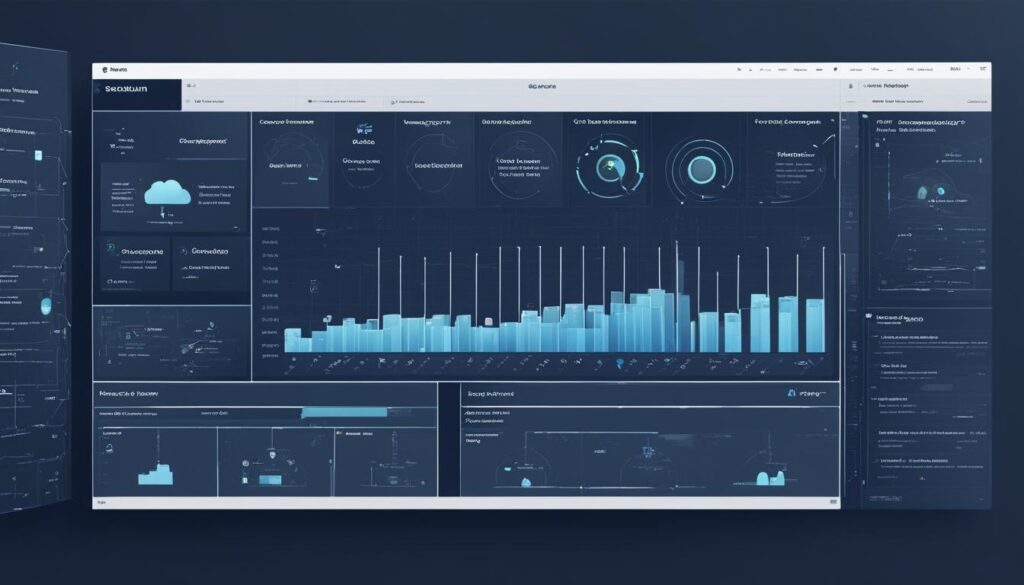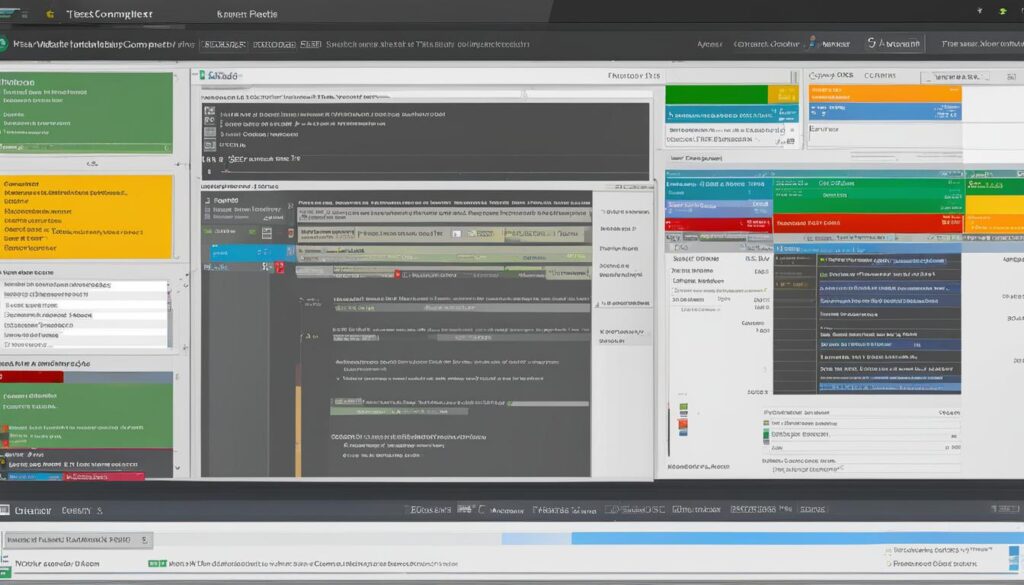Ensuring software quality is essential in the development process, and automation is vital for achieving high standards. At [Your Company Name], we understand the importance of effective testing practices and are committed to using the best SQA automation tools available.
In this article, we will explore a comprehensive list of SQA automation tools that streamline the testing process, enhance productivity, and deliver reliable results. Whether you are a beginner or an experienced QA professional, these tools have the features and capabilities to meet your specific testing needs.
Key Takeaways:
- SQA automation tools are essential for efficient software testing and quality assurance.
- Choosing the right automation tool depends on your specific needs and requirements.
- The top SQA automation frameworks include Selenium, Scandium, Appium, TestComplete, and Katalon Studio.
- These tools offer a range of features, support for different programming languages, and user-friendly interfaces.
- Effective automation tools contribute to industry-leading software quality and user satisfaction.
Selenium – A Popular Open-Source Test Automation Framework
Selenium is a widely used open-source test automation framework known for its robust features and extensive community support. It offers tools and libraries for automating web applications and supports multiple programming languages such as Java, Python, and C#. Selenium is a popular choice for beginners due to its vast online resources and community support, making it easier to find help and resources.
Key Features of Selenium:
- Open-source test automation framework
- Designed for automating web applications
- Supports multiple programming languages
- Extensive community support and online resources

The Benefits of Scandium
Scandium brings numerous benefits to the table:
- No-code test automation: No programming skills required, making it accessible to beginners.
- Time savings: Record-and-playback feature accelerates test creation and execution.
- Easy test maintenance: Modify and update tests effortlessly with Scandium’s intuitive interface.
- Efficient test case management: Organize and execute tests with ease using Scandium’s robust features.
With its no-code approach, intuitive interface, and powerful features, Scandium is transforming the way we approach test automation. Whether you’re just starting or have years of experience, Scandium is a valuable addition to any QA professional’s toolkit.
Appium – A Fantastic Choice for Mobile App Testing
When it comes to mobile app testing, Appium stands out as a fantastic choice. As an open-source tool, it offers a range of features that make testing native, hybrid, and mobile web applications a breeze on both Android and iOS platforms. With its cross-platform capabilities and support for multiple programming languages, Appium is an excellent option for beginners and experienced testers alike.
One of the key advantages of using Appium is its open-source nature. This means that developers and testers can access and modify its source code, making it highly customizable to meet specific testing needs. Appium’s open-source community is also active and supportive, providing valuable resources, documentation, and updates.
Native, Hybrid, and Mobile Web Applications
Appium allows for seamless automation of native, hybrid, and mobile web applications. This versatility makes it incredibly convenient for testing various types of mobile apps, ensuring consistent performance and functionality across different platforms.
Whether you’re developing a native app specifically for Android or iOS or working on a hybrid app that combines web and native elements, Appium has you covered. It offers the necessary tools and features to automate your tests, providing accurate results and valuable insights.
Cross-Platform Capabilities
Appium’s cross-platform capabilities are invaluable for teams working on applications that need to run smoothly on both Android and iOS platforms. Instead of developing separate test scripts for each platform, Appium allows you to write tests once and execute them on multiple platforms, saving time and effort.
This cross-platform compatibility also extends to the programming languages supported by Appium, such as Java, Python, Ruby, and C#. This flexibility enables testers to write tests in their preferred language, leveraging their existing skills and knowledge.
Furthermore, Appium’s compatibility with popular integrated development environments (IDEs) like Eclipse, IntelliJ IDEA, and Visual Studio ensures a seamless integration within your existing development workflow.

Appium’s ability to test mobile apps across different platforms and its support for multiple programming languages make it a powerful tool in the hands of testers. Whether you’re a beginner or an experienced QA professional, Appium simplifies the mobile app testing process and helps identify and fix issues before your app reaches the hands of users.
Appium’s flexibility, cross-platform capabilities, and community support have made it a popular choice among mobile app testers. Its open-source nature, combined with its ability to automate native, hybrid, and mobile web applications, ensures comprehensive coverage and reliable results.
TestComplete – User-Friendly Test Automation Tool for Web and Desktop Applications
When it comes to test automation for both web and desktop applications, TestComplete is a top choice. This user-friendly tool offers a range of features that make it easy for beginners and experienced testers alike to create and execute test scripts.
One of the standout features of TestComplete is its record-and-playback capability. This convenient feature allows users to record their interactions with the application and generate test scripts automatically, without the need for extensive coding knowledge. This makes it an ideal choice for testers who may not have programming expertise.
Furthermore, TestComplete provides a wide range of built-in test objects, meaning users have access to a comprehensive library of UI elements and controls specific to web and desktop applications. This built-in functionality enhances ease of use and test creation, as it eliminates the need to manually identify and configure individual UI elements.
With TestComplete, creating and executing tests becomes a streamlined process, allowing testers to focus on ensuring the quality and functionality of web and desktop applications.
| Key Features | Benefits |
|---|---|
| Record-and-playback feature | Efficient test script creation without coding |
| Built-in test objects | Simplified test creation and management |
| Support for web and desktop applications | Versatility to test various types of applications |

TestComplete offers a reliable and intuitive user interface, ensuring that both beginners and experienced testers can navigate the tool effectively. With its extensive capabilities, TestComplete is a valuable asset in any testing arsenal, enabling efficient and thorough testing of web and desktop applications.
Katalon Studio – Comprehensive Automation Tool for Beginners and Experienced Testers
When it comes to automation testing, Katalon Studio stands out as a comprehensive tool suitable for both beginners and experienced testers. Its user-friendly interface, coupled with powerful features, makes it an ideal choice for streamlining testing efforts and achieving efficient results.
One of the standout features of Katalon Studio is its simple and intuitive interface. Testers can quickly familiarize themselves with the tool, allowing for a smooth onboarding process. Whether you’re a beginner or an experienced tester, Katalon Studio’s user-friendly interface ensures that you can easily navigate through the tool and create automated tests without hassle.
Another notable aspect of Katalon Studio is its built-in test frameworks, which provide a solid foundation for test creation. With these frameworks, testers can leverage predefined functions and modules to expedite the test development process. This feature is particularly beneficial for beginners who may not have extensive coding knowledge, allowing them to create robust and reliable tests with ease.
“Katalon Studio’s built-in test frameworks have truly revolutionized the way we approach automation testing. They have drastically reduced our development time and made it possible for our team to focus more on test design rather than writing complex scripts.”
In addition to its user-friendly interface and built-in frameworks, Katalon Studio also offers a scripting option for advanced users. This feature enables experienced testers to further customize their tests by adding complex logic and extensions. With the scripting option, Katalon Studio caters to the diverse needs of automation testers, empowering them to create highly specialized and tailored tests.
Overall, Katalon Studio’s comprehensive set of features, including its simple user-friendly interface, built-in test frameworks, and scripting option, make it an excellent choice for both beginners and experienced testers. Whether you’re just starting your automation journey or looking to enhance your existing testing workflows, Katalon Studio provides the tools you need to achieve efficient and reliable test automation results.
Key Features of Katalon Studio
| Feature | Description |
|---|---|
| Simple and User-Friendly Interface | Katalon Studio offers an intuitive interface that promotes easy navigation and quick adoption. |
| Built-in Test Frameworks | The tool provides prebuilt test frameworks that accelerate test development for efficient automation. |
| Scripting Option | Advanced users can leverage scripting capabilities to customize tests and add complex logic. |

With Katalon Studio, automation testing becomes accessible and efficient, allowing testers to achieve comprehensive test coverage and ensure the quality of their software. Whether you’re a beginner taking the first steps in automation or an experienced tester seeking a versatile tool, Katalon Studio is a reliable choice that empowers you to deliver high-quality software products.
Key Features and Concepts of Scandium
Scandium, our no-code automation tool, offers an array of powerful features designed to enhance your testing experience. With Scandium, you can create and execute tests without writing a single line of code. Let’s explore the key features that make Scandium a valuable addition to your testing toolkit:
No-Code Automation
Scandium’s intuitive interface allows anyone, regardless of their programming background, to design and execute automated tests effortlessly. The record-and-playback feature simplifies the test creation process, empowering testers to focus on identifying critical scenarios and validating software functionality.
Efficient Test Case Management
Organizing test cases is crucial for effective test management. Scandium offers organizational folders that enable you to categorize and manage your test cases efficiently. This feature simplifies navigation and ensures that your test cases remain structured, making it easier to maintain and reuse them in future testing cycles.
Detailed Reporting and Analytics
Scandium provides detailed reporting and analytics capabilities, allowing you to track the progress and results of your test executions. This feature enables you to generate valuable insights and identify patterns and trends in your testing efforts. Clear and comprehensive reports help you communicate the status and quality of your software to stakeholders effectively.
Streamlined Test Case Creation
Creating test cases in Scandium is a breeze. With its user-friendly interface, you can define test steps and events in a logical and structured manner. This feature promotes test case reusability, ensures accurate test coverage, and speeds up the test creation process.
Test Execution and Validation
Scandium simplifies the process of executing and validating your automated tests. With just a few clicks, you can initiate test execution and monitor the progress in real-time. Scandium provides clear and detailed logs, making it easier to identify any issues and validate the functionality of your software.
Scandium’s no-code automation, efficient test case management, detailed reporting, streamlined test case creation, and seamless test execution and validation processes allow you to focus on delivering high-quality software without the burden of extensive coding. It’s the perfect tool to enhance your testing efficiency and achieve your quality assurance goals.
| Feature | Description |
|---|---|
| No-Code Automation | Design and execute automated tests without coding |
| Efficient Test Case Management | Organize test cases effortlessly with organizational folders |
| Detailed Reporting and Analytics | Generate valuable insights with comprehensive reports |
| Streamlined Test Case Creation | Create test cases quickly and accurately |
| Test Execution and Validation | Execute and validate tests with ease |
Choosing the Right Automation Testing Tool
When it comes to automation testing tools, selecting the right one is essential for a successful testing strategy. With the rapid growth of Agile and DevOps practices, teams need tools that align with their specific needs and can seamlessly integrate into their workflows. To make a well-informed decision, teams must consider various factors such as evaluation strategy, features, integrations, maintenance ease, budget, and technical support.
First and foremost, it is crucial to evaluate the specific needs of your team. Identify the requirements and challenges you face in your testing process. Determine whether you need a tool that supports web or mobile app testing, or both. Consider the programming languages that your team works with and ensure the tool has support for those languages.
Additionally, evaluating the scalability of the tool is essential. As your organization grows and your testing needs evolve, you will want a tool that can scale to meet those demands. Look for automation testing tools that offer scalability options, such as the ability to run tests across multiple environments and handle large test suites efficiently.
Integration capabilities with other tools in your development ecosystem are vital for seamless collaboration and efficient workflow. Identify the tools your team currently uses, such as issue trackers, CI/CD platforms, and version control systems, and ensure the automation testing tool can integrate with them. This will help create a connected and streamlined development environment.
Quote: “Choosing the right automation testing tool requires careful consideration of factors such as specific needs, team resources, future scalability, integrations, maintenance ease, budget, and technical support.”
Another crucial aspect to consider is the ease of maintaining test scripts. Test scripts need regular updates and maintenance to ensure they remain accurate and reliable. Look for tools that provide a user-friendly interface and intuitive scripting capabilities, allowing testers to easily maintain and update test scripts without extensive coding knowledge.
However, one cannot overlook the importance of budget constraints. Evaluate your team’s budget and compare it with the cost of the automation testing tools you are considering. It’s essential to strike a balance between the features and capabilities of the tool and your team’s financial resources.
Lastly, technical support is crucial for successfully implementing and maintaining an automation testing tool. Look for vendors that offer comprehensive technical support, including documentation, online resources, and responsive customer support. This ensures that you have access to assistance when facing any challenges or questions during the implementation and usage of the tool.
Sample Evaluation Matrix:
| Factor | Tool A | Tool B | Tool C |
|---|---|---|---|
| Specific Needs | ✓ | ✓ | ✓ |
| Scalability | ✓ | ✓ | ✓ |
| Integrations | ✓ | – | ✓ |
| Maintenance Ease | ✓ | – | ✓ |
| Cost | $$$ | $$ | $$ |
| Technical Support | ✓ | ✓ | ✓ |
Using an evaluation strategy similar to the table above can help you compare different automation testing tools and make an informed decision based on your team’s specific requirements.
Ultimately, choosing the right automation testing tool involves a thorough evaluation of your team’s needs, features offered, integration possibilities, ease of maintenance, budget constraints, and technical support. By carefully considering these factors, you can find the tool that best aligns with your team’s goals and significantly improves your software testing process.
Conclusion
In conclusion, selecting the right SQA Automation Tools is crucial for efficient software testing and ensuring high software quality. The top SQA automation frameworks, including Selenium, Scandium, Appium, TestComplete, and Katalon Studio, offer a wide range of features and cater to different skill levels. These tools streamline the testing process, allowing for efficient and effective testing of software applications.
By using these best automation tools for software testing, QA professionals can generate valuable feedback that leads to software quality improvements. The automation capabilities provided by these tools help identify bugs and issues early on, facilitating prompt resolution and reducing the likelihood of software defects reaching end-users. This results in higher user satisfaction and enhances the overall quality of software products.
With their extensive features, these SQA automation tools enable testers to write maintainable, reusable scripts, execute tests efficiently, and generate detailed reports. The efficiency gained through automation not only saves time and effort but also enables teams to focus on other critical aspects of software development, such as design and innovation.
By leveraging the power of these top SQA automation frameworks, software development projects can achieve efficient testing, valuable feedback, and, ultimately, improved software quality. Investing in the right automation tools is a worthwhile endeavor that can lead to enhanced user satisfaction and successful software products.
FAQ
What are the best SQA automation tools for efficient testing?
The best SQA automation tools for efficient testing include Selenium, Scandium, Appium, TestComplete, and Katalon Studio.
What is Selenium and why is it popular?
Selenium is an open-source test automation framework known for its robust features and extensive community support. It is popular due to its versatility in automating web applications and its support for multiple programming languages.
What is Scandium and how is it different from other tools?
Scandium is an emerging no-code test automation tool that stands out for its intuitive record-and-playback feature. It allows users to create automated tests without writing code, making it suitable for both beginners and experienced QA professionals.
How does Appium differ from other automation tools?
Appium is a popular open-source tool designed specifically for mobile app testing. It supports automation of native, hybrid, and mobile web applications on both Android and iOS platforms, making it a fantastic choice for mobile app testing.
What makes TestComplete a user-friendly test automation tool?
TestComplete is user-friendly due to its record-and-playback feature, which allows beginners to create test scripts without extensive coding knowledge. It also provides a wide range of built-in test objects, enhancing ease of use and test creation.
What are the key features of Katalon Studio?
Katalon Studio is a comprehensive automation tool suitable for beginners and experienced testers. It features a simple and user-friendly interface, built-in test frameworks, and a scripting option for advanced users, accommodating testers with varying skill levels.
What are the key features of Scandium?
Scandium offers key features such as no-code test automation, efficient test case management, detailed reporting and analytics, test case creation, organizational folders, test steps and events, and test execution and validation.
What factors should be considered when choosing an automation testing tool?
When choosing an automation testing tool, factors such as specific needs, team resources, future scalability, integrations, maintenance ease, budget, and technical support should be considered. Evaluation of features, integrations, support, and cost is crucial for selecting the right tool.









